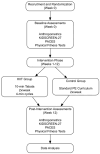Enhancing Adolescent Physical Fitness and Well-Being: A School-Based High-Intensity Interval Training Program
- PMID: 39728263
- PMCID: PMC11676439
- DOI: 10.3390/jfmk9040279
Enhancing Adolescent Physical Fitness and Well-Being: A School-Based High-Intensity Interval Training Program
Abstract
Background: The aim of this study is to investigate the effects of a school-based high-intensity interval training (HIIT) program on quality of life and physical fitness in adolescents. Methods: The study included 60 male adolescents (16.2 ± 0.6 years), randomly assigned to one of two groups: the HIIT group (n = 30) and the control group (CG, n = 30). Participants completed the KIDSCREEN-27 questionnaire to evaluate quality of life and physical fitness tests, including vertical jump, repetitive strength, agility, and flexibility. The experimental program consisted of a 12-week intervention integrated into the warm-up phase of regular physical education (PE) classes. Each PE class lasted 45 min, with the HIIT regimen occupying 10 min of the warm-up phase. The HIIT sessions followed a Tabata-style structure, performed twice weekly. A two-way ANOVA with repeated measures assessed group and time interaction effects. Results: The results revealed changes in physical well-being following the HIIT intervention (p = 0.01) compared to the control group (p = 0.42). The results of the two-way ANOVA with repeated measures revealed interaction effects between group and time for the various fitness tests, countermovement jump (p = 0.04), 4 × 10 m agility test (p = 0.02), medicine ball throw test (p = 0.04), and sit-ups (30 s) (p = 0.01). Conclusions: This study highlights the effectiveness of school-based HIIT in significantly enhancing physical well-being and physical fitness among adolescents.
Keywords: classes; intervention; physical health; well-being; young.
Conflict of interest statement
The authors declare no conflicts of interest.
Figures


References
-
- Altavilla G. Relationship between Physical Inactivity and Effects on Individual Health Status. J. Phys. Educ. Sport. 2016;16:1069–1074.
-
- Reigal R.E., Videra A., Parra J., Juárez-Ruiz de Mier R. Psychological Benefits of Physical Exercise in Adolescence. Rev. Psicol. Deporte. 2014;23:323–329.
-
- Pires-Júnior R., Coledam D.H.C., de Aguiar Greca J.P., de Arruda G.A., Teixeira M., de Oliveira A.R. Physical Fitness and Health-Related Quality of Life in Brazilian Adolescents: A Cross-Sectional Study. Hum. Mov. 2018;19:3–10. doi: 10.5114/hm.2018.74055. - DOI
-
- O’Donovan G., Blazevich A.J., Boreham C., Cooper A.R., Crank H., Ekelund U., Fox K.R., Gately P., Giles-Corti B., Gill J.M.R., et al. The ABC of Physical Activity for Health: A Consensus Statement from the British Association of Sport and Exercise Sciences. J. Sports Sci. 2010;28:573–591. doi: 10.1080/02640411003671212. - DOI - PubMed
LinkOut - more resources
Full Text Sources

